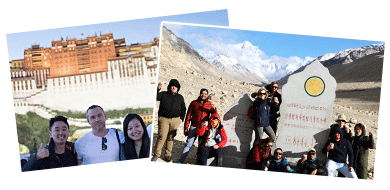
The incredible Annually growing travel flow of Qinghai Tibet Raiwaly
The Qinghai-Tibet Railway has boosted Tibet’s tourism and economy as well as its economic and cultural communication with the outside world. It has improved the life of the people on the plateau. However, the Qinghai-Tibet Railway also has its negative impacts on Tibet.

Passengers were waiting to board the train in Lhasa
Tibet Vista is a professional Tibet train tour operator, If you are interested in booking Tibet train tickets or have any question about Qinghai-Tibet train journey or travelling in Tibet, please feel free to send us an inquiry. We will do our best to help you out.
In recent years Tibet's tourism has expanded rapidly, especially after the completion of Qinghai-Tibet Railway in July 2006.
In 2006, Tibet received 2.5 million tourists, including 150,000 foreign visitors. Most of them took train to Tibet to experience the newly-built railway and mainly to enjoy the breathtaking scenery along the railway to Tibet.
In 2007, Tibet received 4 million tourists from both home and abroad, up 60% from the previous year, generating an income of 4.86 billion RMB, 75 percent higher than in 2006, according to the Tibet Tourism Bureau.
In 2008, Tibet received 2.25 million tourists with the total revenue standing at 2.26 billion RMB, down 44.2 percent and 53.4 percent respectively from the previous year, due to the effect of the March 14 riot in 2008.
In 2009, Tibet’s tourism rebounded. Tibet received 5.56 million tourists from both home and abroad, with revenue of 5.2 billion RMB, up 147 percent from 2008.
In 2010, Tibet, in total, received 6.85 million tourists from home and abroad, 3.8 times more than in 2005. The total revenue was 7.14 billion RMB, 3.7 times as much as that of 2005.
In 2011, Tibet received 8.7 million tourists from home and abroad, up 26.9 percent from the previous year. Its tourism revenue totaled 9.7 billion RMB in 2011, up 35.8 percent from 2010.
In 2012, Tibet received 10.58 million tourists from home and abroad, up 21.7 percent from the previous year. The total revenue was 12.65 billion RMB, up 30.3 percent from 2011.
In 2013, Tibet received 10.58 million tourists from home and abroad, up 21.7 percent from the previous year. The total revenue was 12.65 billion RMB, up 30.3 percent from 2011.
The above data certainly demonstrates that the Qinghai-Tibet Railway greatly promotes Tibet’s tourism, which is a crucial factor in Tibet’s economy. Many local Tibetans also benefit from the development of Tibet’s tourism. Many farmers gave up farming to set up businesses catering for tourists, work as tour guides or drivers, run family hotels or restaurants, make handicrafts, etc.
With the operation of the railway, the overall transport infrastructure and investment environment in Tibet have been upgraded greatly. Many businesspeople and investors are also attracted to this land, with its great potential.
Many modern machines are carried to Tibet via the railroad to build roads in Tibet. Nowadays, well-paved roads can be found in and between major areas of Tibet. Traditionally horses were the only mode of transportation, but with the improvements made in infrastructure, people have switched to motorbikes or cars, which have made life much easier for the locals.
Tibet will also see more railtracks in near future. The construction of the Qinghai-Tibet Railway is actually finished and it is being extended to Shigatse, Tibet’s second largest city, then further to Kathmandu, the capital of Nepal. Construction of another extension of the Qinghai-Tibet Railway, the Lhasa-Nyingchi Railway will be started soon. The history of the Qinghai-Tibet Railway will be re-written soon.
Besides, in the future, there will be more railways built to Tibet from mainland China. For instance, the 1,900 km long Sichuan-Tibet Railway, with investment of about 130 billion RMB will be constructed soon, and it will link the Lhasa-Nyingchi Railway after being completed. Also, construction of Yunnan-Tibet Railway and Xinjiang-Tibet Railway may also be on the agenda before long.
The railway provides a low-cost, 24-hour means of mass transportation, it accelerates the blending of Tibet’s economy and culture with that of mainland China, bringing considerable benefits to Tibet’s mineral and material products, ethnic handicrafts and arts.
However, modernization may also be a great threat to the traditions. Critics say modernization is happening at a cost to the region’s cultural heritage. The Qinghai-Tibet railway has opened the vast expanses of Tibet to the world and brought new concepts to the once isolated plateau.
Will the prayer wheels, buttered tea, and people lining up to kowtow disappear with the appearance of cups of coffee, pizza, ice-cream, and music bars? We do not know.

Mr. Derek Wong is sales manager of Tibet Vista Tour as well as designer of Tibet Vista websites and has been providing specialized travel services to Tibet Vista travelers for years. He has continued to hone his professional expertise by completing numerous travel specialist courses to China and Tibet and Nepal and Bhutan.


.jpg)





0 Comment ON "The incredible Annually growing travel flow of Qinghai Tibet Raiwaly"